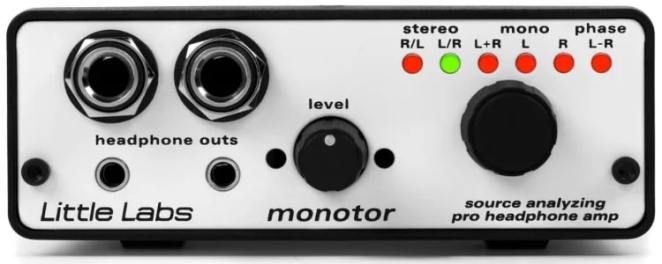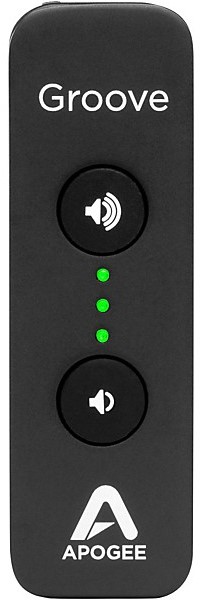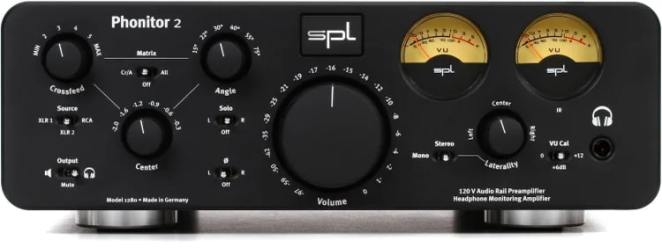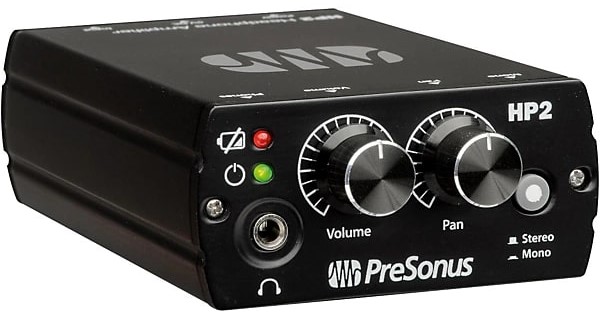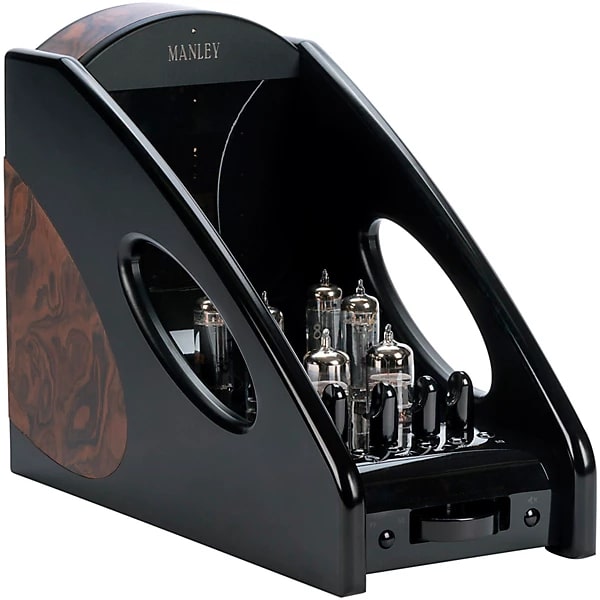When you buy through our links, we may earn an affiliate commission.
Headphone amplifiers may just be some of the most secretive devices in the audio world. In fact, you probably never even heard of them if you're not an audiophile yourself.
But these tiny devices actually turn out to be a key component in your audio signal if you have high-end headphones! If you bought a new pair of headphones and you can't seem to get them to work, this may just be the piece of the puzzle you're missing.
A headphone amp will allow you to power up your headphones correctly, improving the overall volume and sound quality.
In this article, I have picked out the seven best headphone amplifiers on the market for every budget and usage scenario. I also threw in a short, yet comprehensive buyer's guide to help you out if you're shopping for your first amp.
Our top pick is the Little Labs Monotor 2 — a mid-range amp that delivers everything from flexible I/O to phase monitoring.
The right headphone amp will allow you to enjoy your headphones at the maximum level, while also improving your setup's overall sound quality. Let's find the right one for you!
Quick Summary of the Best Headphone Amps
- Little Labs Monotor 2 (Best Overall)
- Mackie HM-4 (Best for Tight Budgets)
- Apogee Groove (Best for Everyday Use)
- ART HeadAmp6Pro (Best for Multiple Headphones)
- SPL Phonitor 2 (Best High-End Amp)
- PreSonus HP2 (Best for Playing Live)
- Manley Absolute (Best Tube Amplifier)
Best Headphone Amps
Best Overall
SPECS
- I/O: 5 inputs and 4 outputs
- Format: Desktop or rack
- Phase monitoring: Yes
What Could Be Improved
- Not the cheapest
The Little Labs Monotor 2 manages to strike an unbelievable balance between quality, price, and versatility. This tiny beast was made by audio engineers for audio engineers — and I can assure you it does not disappoint.
The Monotor 2 is equipped with state-of-the-art circuitry that handles massive capacitance, greatly improving the dynamic range of your headphones. On the front you'll find two 1/4" and 1/8" outputs, while on the back you'll find the input jacks.
But by far the most revolutionary feature of the Little Labs Monotor 2 is its extensive mono-monitoring settings, which allow you to check for phase and artifact issues in your mixes.
All in all, the Little Labs Monotor 2 is the best headphone amplifier for pretty much everyone. If you're looking to get your mixes to a whole new level, or you just want to take full advantage of your headphones' sound, then you just can't go wrong with this one.
Best for Tight Budgets
SPECS
- I/O: 1 input and 4 outputs
- Format: Desktop
- Phase monitoring: No
What Could Be Improved
- Can't be battery-powered
Now, audio gear can get very expensive, very quickly — and headphone amps are certainly no exception. Cue in the Mackie HM-4, an affordable 4-way headphone amp that barely breaks the 40-dollar barrier.
And honestly? It somehow still manages to pack in an amazing number of features.
Thanks to its top-notch analog circuitry, the Mackie HM-4 provides ample headroom with a minimum noise floor, all while featuring four output jacks. Of course, each output is equipped with its own volume control, and the whole device is powered by a 12V supply.
Naturally, the Mackie HM-4 may not be the best option purely for improving your headphones' sound quality. But it's a fantastic choice for musicians looking to split their live sound into multiple signals for real-time monitoring!
Best for Everyday Use
SPECS
- I/O: 1 USB input and 1 output
- Format: Desktop
- Phase monitoring: No
What Could Be Improved
- Limited I/O
- Austere controls
The Apogee Groove is everything the casual audiophile could ask for: affordable, stylish, and of stellar quality. Despite its simplistic and sleek design, the Apogee Groove manages to rival most headphone amplifiers on the market by delivering top-notch sound and versatility.
Covering the ground between digital-to-analog converters and headphone amps, this compact beast only features one headphone jack and one USB input. The same austere logic also applies to the controls: you'll only find two volume buttons on the whole amp.
So what's so magical about the Apogee Groove? Well, the truth is that there's just no other amp that can rival its accessibility. Just plug it into your computer and you're good to go!
As such, it's the perfect option for home studio enthusiasts or even non-musicians who are looking to improve their everyday audio quality. And, taking into account the price, you just can't go wrong with the Apogee Groove.
Best for Multiple Phones
SPECS
- I/O: 6 inputs and 6 outputs
- Format: Rack
- Phase monitoring: No
What Could Be Improved
- Not desktop-friendly
The team at ART understands that not everything about headphone amps has to do with sheer sound quality. Much like the Mackie HM-4, the ART HeadAmp6Pro wants to give you the maximum amount of outputs without having you break the bank for it.
The HeadAmp6Pro manages to offer six (yes, six) independent headphone outputs with individual pan, EQ, and volume controls for each. It also includes XLR and 1/4" inputs, handy LED meters, an AUX input, and a front panel Main Insert Jack.
The ART HeadAmp6Pro is also rack-compatible, making it a fantastic choice for advanced producers looking to set up a more serious recording studio. And the best part? It barely crosses the 300-dollar barrier.
Best High-End Amp
SPECS
- I/O: 6 inputs and 2 outputs
- Format: Desktop
- Phase monitoring: Yes
What Could Be Improved
- Expensive
- Not for moving around
Now, I get it: some people just want the best of the best. In that sense, the SPL Phonitor 2 is, by far, the best headphone amp for audiophiles who don't mind spending a few extra bucks. And you can tell just by the way it looks — this powerhouse of an amp is here to revolutionize your studio.
Thanks to its cutting-edge circuitry designed to operate at 120V, the Phonitor 2 provides a jaw-dropping 150dB of dynamic range. Forget about noise interfering with your listening experience — this ample headroom allows for accurate monitoring at any volume.
While the SPL Phonitor 2 only provides two outputs, the revolutionary Phonitor Matrix allows you to recreate the loudspeaker experience with your favorite headphones. And we didn't even mention the best part: the Phonitor 2 features two mesmerizing VU meters that give it a much-appreciated vintage touch.
Best for Playing Live
SPECS
- I/O: 1 input and 1 output
- Format: Portable
- Phase monitoring: No
What Could Be Improved
- Limited I/O
The PreSonus HP2 is, undoubtedly, the best portable headphone amp on the market today. While the concept is similar to the Mackie HM-4, the HP2 is entirely focused on giving you the best possible experience on-stage — perfect for the most demanding gigging musicians.
The main feature of the PreSonus HP2 is that it can be completely powered by a 9V battery. Pair that with the included belt clip, and you can forget about low-quality audio when you're up on the stage.
As far as outputs go, the HP2 aims for an individual experience, offering only one stereo jack and two input XLR connectors. But taking into account its affordable price, it shouldn't be a problem to get one for each of your bandmates!
Best Tube Amplifier
SPECS
- I/O: 2 inputs and 3 outputs
- Format: Desktop
- Phase monitoring: No
What Could Be Improved
- Very expensive
- Somewhat fragile
- Did we mention expensive?
Now, the Manley Absolute is not for the faint-hearted. Its ludicrous price tag will scare away even the most dedicated of audiophiles — but if you're looking for the best of the very best, this is it.
Unlike pretty much every other headphone amp on the market, the Manley Absolute is a tube amplifier, making it a true work of art when it comes to audio gear. Warmth and transparency are the name of the game here, and its many gain settings reflect that.
I/O isn't a problem either, as the Manley Absolute features several inputs and outputs for all your monitoring needs. In fact, you don't need to worry about anything if you're buying this monster — after all, we're talking about a Manley here.
Best Headphone Amps Buyer's Guide
Headphone amplifiers are some of the most complicated pieces of gear in the audio market. And, to make matters worse, there are very few (or dare I say none) good guides that explain the basic concepts of these tiny devices.
But fret not! I put together a short buyer's guide so you can learn all you need to know before you purchase your first headphone amp:
I/O Capabilities
Similarly to quality guitar headphone amps, the first thing to look out for when shopping for a general use headphone amp is how many inputs and outputs it features. Will a single output be enough for you? Or are you looking to supply your band's in-ear monitors while playing live?
Of course, the age-old formula of simply adding up the outputs and inputs will give you the featured I/O in a certain device — but things are a bit more complicated than they seem. Particularly because there are different types of inputs and outputs.
The main thing to understand is analog and digital inputs and outputs. Analog signals are transferred by connectors such as XLR, RCA, Speakon, and TS (and its variations). Analog I/O are the most common signals you'll be dealing with — especially if you're a musician.
But if you want to connect your headphone amp directly to your computer, you'll be using digital inputs and outputs instead. These usually go through USB, Optical/TOSLINK, and Firewire connectors.
Impedance
Now we get to the complicated stuff: impedance. To put it in simple terms, impedance is the natural resistance a certain device has when it comes to transmitting an audio signal. If you aren't able to match (and ideally surpass) that impedance, the signal won't come through.
For example, let's say you have headphones with a set impedance of 250 ohms (the measurement for impedance). If your audio device has a lower impedance, you won't be able to hear pretty much anything.
But the opposite is also true! If you surpass the impedance by a lot, you'll overpower your headphones, possibly damaging them permanently. As such, it's essential to find a headphone amp that "matches" your needed impedance.
Luckily, pretty much all headphone amplifiers display their impedance somewhere on the specs sheet. But don't forget to check your headphones' manual too!
Solid State vs Tube Amplifiers
If you're a guitarist or a bassist, you're probably already familiar with this aspect. While most headphone amplifiers are solid-state, there are a few models out there that still use tubes. The most glaring example of this is, of course, the Manley Absolute.
Solid state amps are standard in the audio market, as they're rather cheap to manufacture and durable. But the main benefit of solid state amps is that they sound pretty much the same at all volumes, offering transparency and accurate audio monitoring. You won't get the real feel for your music sound as with a regular solid state guitar amp like Fender '65 Princeton Reverb but you won't be making any noice while practicing.
Tube amps, instead, were the standard back in the day. Although they sound absolutely fantastic due to their warmth and grit, they require loud volumes to sound correctly. But, again, you just can't beat the tube sound quality.
In pretty much all cases, solid state headphone amplifiers are the right choice. But if you're a demanding audiophile, and budget is not a problem, then a vintage-style amp may just be the perfect option for you.
Phase Monitoring
Now, if you're an experienced producer, the mere words "phase issues" can make you have nightmares tonight. Headphone amplifiers won't fix them manually — but they do offer some solid options for checking for them.
Amps such as the Little Labs Monotor 2 offer different settings for checking phase and artifacts. For example, you could disable left and right channels individually, add them together, or substract them to ensure there aren't any phase cancellation issues.
If you've ever recorded with stereo mics, you can think of this as the same procedure as adding up Mid/Side — but in reverse. I can't stress enough how useful this is, so make sure you try to get a headphone amp that has multiple phase-related settings.
But, again, if you're a casual listener, you might not need such complex features. After all, you probably aren't looking to solve phase issues when you're playing a video game!
DAC vs Audio Interface vs Headphone Amplifier
If you're a beginner audiophile, you might feel a bit... lost regarding exactly what you need. DACs, audio interfaces, and headphone amplifiers all seem a bit too similar, right?
Well, yes — but they all serve different purposes.
An audio interface works as a sort of "central hub" in your audio recording setup. These devices can effectively communicate audio signals between your computer and the analog world, making them a crucial piece in any home studio.
DACs, on the other hand, only do one thing: convert digital audio into analog signals. This allows you to output your signal into a speaker or headphones. However, unlike headphone amplifiers, these don't necessarily solve impedance issues.
Headphone amplifiers, instead, DO solve impedance issues — but don't necessarily work as analog/digital mediators. A few can, however, and you could get away with using a headphone amplifier instead of an external DAC in some cases.
Frequently Asked Questions (FAQs)
What is the point of a headphone amp?
The main point of a headphone amp is to match the power of your signal to the one appropriate for your headphone setup. If you aren't an audiophile, you probably have never come across impedance problems in your setup — and, honestly, it's unlikely that you ever will.
But if you're all about sound quality, you may have noticed that buying high-end headphones isn't as simple as it seems. Headphone amplifiers solve pretty much all your power-related problems, but it's also important to remember that they aren't the only piece of the puzzle!
Depending on your setup, you may also need a digital-to-analog converter (DAC) or an audio interface to correctly transmit your signal to your amp. There's nothing worse than buying an expensive pair of headphones and not being able to use them — so make sure you do some research first!
Do I need a DAC and amp for headphones?
Well, it all depends on your specific setup.
As far as needing a DAC goes, you only need that if you aren't processing your signal through a high-quality interface. A great example of this are TVs, which feature low-quality converters that can downgrade your listening experience. As such, many audiophiles choose to incorporate a DAC into their home theater to improve overall sound quality.
Headphone amplifiers, on the other hand, are only (or mostly) necessary if you have high-end headphones that need extra power — remember when I talked about impedance? Most modern headphones have an impedance of 32 ohms, but top-of-the-line headphones may go as far as 800.
Most audio interfaces, mobile phones, and integrated DACs can easily handle 32-ohm headphones, but not much else. So if you're planning on getting a pair of specialized audiophile headphones, you'll probably need an amp to handle that extra impedance.
Do all headphone amplifiers sound the same?
Theoretically, all headphone amplifiers should sound pretty much the same — provided they have similar specs. However, this may vary depending on several factors.
For example, more expensive amps may have a better sound due to higher-quality analog circuitry. The same logic can be applied to the amplification itself too, as high-end gear may take advantage of more modern techniques to provide a more transparent experience.
But remember that the difference won't be massive! In fact, only the most demanding of audiophiles will be able to tell the difference between, for example, the Little Labs Monotor 2 and the SPL Phonitor 2 only through sound quality.
Is it OK to leave a headphone amp on all the time?
With any audio gear comes the age-old question of whether it's okay or not to leave it on all the time.
The truth is that there aren't any significant downsides to leaving your headphone amp on for as long as you want to. In fact, some people claim that audio gear lives longer that way, as the device doesn't have to go through cold/warm cycles all the time.
But remember that leaving any electrical device on all the time can have an impact on the environment! Furthermore, there's always the risk of a slight interference in the electrical current damaging your amp. So, in the end, the decision is up to you — but I recommend turning it off every once in a while.
Can headphone amps damage headphones?
Yes, headphone amplifiers can most certainly damage a pair of headphones if you're not careful.
The most common example of this is plugging standard headphones into a highly specialized amp. Because the amp's impedance will likely be much higher than the usual 32 ohms most headphones have, you may end up overpowering your headphones.
In turn, this will make the drivers (the speakers) go crazy, damaging themselves in the process. Similarly, the excess current may damage the circuitry inside the headphones, as they may not be ready to handle such power.
To avoid this, always make sure your amp's impedance "matches" the one of your headphones. While they don't have to be exactly the same, you should be careful if there's a big difference.
Verdict
A headphone amp is a crucial component in your signal chain — and even more so if you're an audiophile interested in getting high-end headphones. Remember that if you try to plug in high-impedance headphones to an integrated DAC or audio interface, you probably won't hear any sound coming out!
A good headphone amp should have flexible I/O, high-quality circuitry, and multiple listening configurations. You should also check for impedance compatibility and make sure it can power up your favorite headphones.
Our top pick is the Little Labs Monotor 2, which offers each and every feature you'll ever need at an affordable price. If you're on a tight budget, however, you may want to take a look at the Mackie HM-4 instead.
Yet if budget isn't a problem, I suggest you skip straight to the monster amps — particularly, the SPL Phonitor 2 or the Manley Absolute. But be warned: prices can get a bit... hefty, to say the least.
